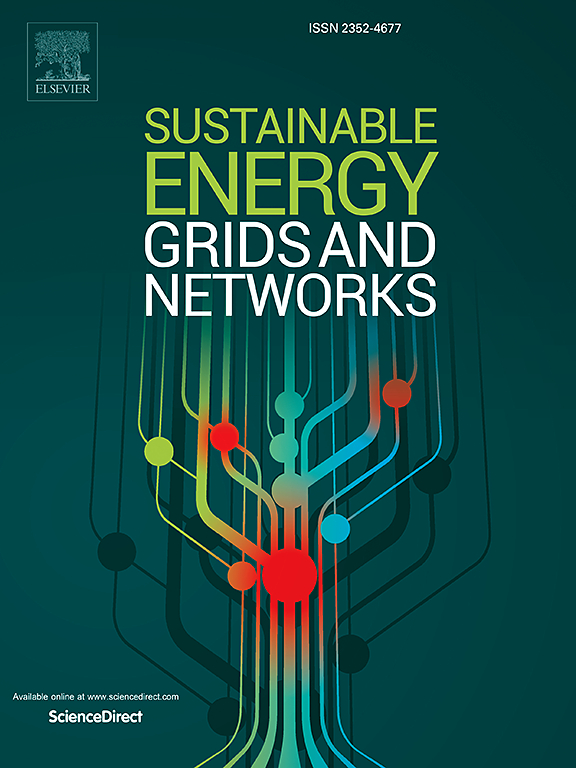热浪期间配电网故障预测:应用于米兰配电网的机器学习模型的比较研究
IF 5.6
2区 工程技术
Q2 ENERGY & FUELS
引用次数: 0
摘要
气候变化加剧了极端天气事件的频率和严重程度,如米兰的热浪,这对配电系统的可靠性和弹性构成了重大挑战。随着这些事件变得越来越不可预测,传统的确定性规划方法变得越来越不合适。本研究引入了一种新的机器学习方法来增强热浪期间的电网弹性,重点关注故障预测和热浪预测。系统地评估了三种互补的方法:递归特征消除和交叉验证的岭回归、随机森林回归和递归特征消除和交叉验证的二阶多项式泊松回归。通过结合土壤温度、湿度梯度和动态负荷需求模式的创新特征工程,预测精度比传统方法显著提高。严格的交叉验证和统计验证证明了模型在不同条件下的稳定性,二阶多项式泊松模型在预测故障发生时的平均绝对误差为0.15 。为了解决高故障期观测到的异方差,开发了自适应预测区间,在最重要的时候为运营商提供关键的不确定性量化。当将这些模型转化为实际操作时,这些模型使配电系统运营商能够实施主动故障管理策略,在极端天气事件中可能将停电响应时间减少约15 - 20%。这项研究弥合了气候科学和电力系统工程之间的关键差距,为城市配电网面临的日益不稳定的运营环境提供了数据驱动的决策支持。本文章由计算机程序翻译,如有差异,请以英文原文为准。
Predicting faults in power distribution grids during heatwaves: A comparative study of machine learning models applied to Milan distribution network
The increasing frequency and severity of extreme weather events, such as heatwaves in Milan, intensified by climate change, pose significant challenges to the reliability and resilience of electrical power distribution systems. Traditional deterministic planning methods are becoming inadequate as these events grow more unpredictable. This study introduces a novel machine learning methodology to enhance grid resilience during heatwaves, focusing on fault prediction and heatwave forecasting. Three complementary approaches were systematically evaluated: Ridge Regression with Recursive Feature Elimination and Cross-Validation, Random Forest Regression, and Second-order Polynomial Poisson Regression with Recursive Feature Elimination and Cross-Validation. Through innovative feature engineering incorporating soil temperature, humidity gradients, and dynamic load demand patterns, predictive accuracy was significantly improved over conventional methods. Rigorous cross-validation with statistical validation demonstrated model stability across varying conditions, with the Second-order Polynomial Poisson model achieving a mean absolute error of 0.15 in predicting fault occurrences. To address the observed heteroscedasticity during high-fault periods, adaptive prediction intervals were developed, providing operators with crucial uncertainty quantification when it matters most. When translated to operational reality, these models enable Distribution System Operators to implement proactive fault management strategies, potentially reducing outage response times by an estimated 15–20 % during extreme weather events. This research bridges the critical gap between climate science and power system engineering, offering data-driven decision support for the increasingly volatile operational environment facing urban distribution networks.
求助全文
通过发布文献求助,成功后即可免费获取论文全文。
去求助
来源期刊

Sustainable Energy Grids & Networks
Energy-Energy Engineering and Power Technology
CiteScore
7.90
自引率
13.00%
发文量
206
审稿时长
49 days
期刊介绍:
Sustainable Energy, Grids and Networks (SEGAN)is an international peer-reviewed publication for theoretical and applied research dealing with energy, information grids and power networks, including smart grids from super to micro grid scales. SEGAN welcomes papers describing fundamental advances in mathematical, statistical or computational methods with application to power and energy systems, as well as papers on applications, computation and modeling in the areas of electrical and energy systems with coupled information and communication technologies.
 求助内容:
求助内容: 应助结果提醒方式:
应助结果提醒方式:


